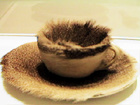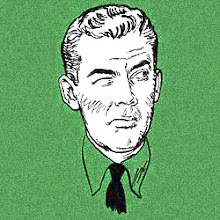 One of the treasures of PennSound is a long interview/conversation with Bern Porter conducted by his long-time friend and collaborator Dick Higgins. There are two parts of the sound file. At around 34 minutes into the first recording, the two begin to talk about their first collaboration - and then, later, their first meeting - in 1959-1960.
One of the treasures of PennSound is a long interview/conversation with Bern Porter conducted by his long-time friend and collaborator Dick Higgins. There are two parts of the sound file. At around 34 minutes into the first recording, the two begin to talk about their first collaboration - and then, later, their first meeting - in 1959-1960. [] Listen to the excerpt about 1959-60: mp3
[] Listen to the whole discussion: mp3
[] Go to the Bern Porter PennSound author page: link
Bern Porter and Dick Higgins first made contact with one another in 1959. Ray Johnson and Bern had been exchanging items through the Mail Art project, Ray sending collages, Bern altering them somewhat and sending them back. Bern was living in Maine at this point, having come back to the U.S. from Tasmania. Young Dick Higgins, about to go off to printing school, was given by Ray Johnson a brochure by Bern Porter that Bern had sent (something Bern had produced in 1947).
Dick loved the pamphlet and sent Bern some of his manuscripts. Bern loved them and wrote immediately back, inviting Dick to contribute to "Bern Porter Editions."
Dick sent Bern the manuscript of What Are Legends. Bern hand-lettered the book and Dick took it to the printing school, where it was printed with Bern's illustrations. This was in 1960.
 One of Higgins' obits began this way: "DICK HIGGINS'S first book was entitled What Are Legends: a clarification. Higgins was himself a bona fide legend, for the books he published rather than wrote. A seminal figure in the Sixties avant-garde, in that astonishing decade of innovation and experimentation whose legacy seems dimmed today by a return to formalism, he was typically protean: poet, performer, composer, visual artist and filmmaker. Yet it was as founder, designer and publisher of the Something Else Press that he remains best known."
One of Higgins' obits began this way: "DICK HIGGINS'S first book was entitled What Are Legends: a clarification. Higgins was himself a bona fide legend, for the books he published rather than wrote. A seminal figure in the Sixties avant-garde, in that astonishing decade of innovation and experimentation whose legacy seems dimmed today by a return to formalism, he was typically protean: poet, performer, composer, visual artist and filmmaker. Yet it was as founder, designer and publisher of the Something Else Press that he remains best known."

 Is '60 the moment when the end of the end of the Old Left had been reached and the New Left began to emerge? Is it the final ascendancy, in certain scenes at least, of poetic postmodernity? Surely the publication of Donald Allen's The New American Poetry that year suggests this, but then again--once again--we look back on "New" here and see continuity. The rhetoric of the Kennedy-Nixon contest made much less of a dent than everyone (at the time as well as since) claimed, so one wonders why were such great claims made?
Is '60 the moment when the end of the end of the Old Left had been reached and the New Left began to emerge? Is it the final ascendancy, in certain scenes at least, of poetic postmodernity? Surely the publication of Donald Allen's The New American Poetry that year suggests this, but then again--once again--we look back on "New" here and see continuity. The rhetoric of the Kennedy-Nixon contest made much less of a dent than everyone (at the time as well as since) claimed, so one wonders why were such great claims made?  Had we come to expect "1960" to be truly ubiquitously modern in a way that the 1950s really were not--not quite? And what specifically does "modern" mean in the Kennedyesque talk then and now about the torch being passed to a new generation, etc.? The First Lady really meant "modernist" when Camelotians said "modern." What about the others across the new young cultural leadership? I've been surprised by how frequently the
Had we come to expect "1960" to be truly ubiquitously modern in a way that the 1950s really were not--not quite? And what specifically does "modern" mean in the Kennedyesque talk then and now about the torch being passed to a new generation, etc.? The First Lady really meant "modernist" when Camelotians said "modern." What about the others across the new young cultural leadership? I've been surprised by how frequently the  "Beat movement" was covered in 1960 in the mainstream press. I was expecting a fair measure but I've found tonnage. 1960 was the year when the figure of the beat was beginning to find acceptance, although still 80% of these stories are mocking, rebels-without-cause condescension. For anyone whose analysis made an impact nationally, do these antipolitical adolescents count as part of the "new young cultural leadership"? No, but rather than the two being opposites, they fall along a Continuum of the New American. Now that's a change for '60.
"Beat movement" was covered in 1960 in the mainstream press. I was expecting a fair measure but I've found tonnage. 1960 was the year when the figure of the beat was beginning to find acceptance, although still 80% of these stories are mocking, rebels-without-cause condescension. For anyone whose analysis made an impact nationally, do these antipolitical adolescents count as part of the "new young cultural leadership"? No, but rather than the two being opposites, they fall along a Continuum of the New American. Now that's a change for '60.







